Keywords
|
| Bit Error Rate (BER), Gigabit Passive Optical Network (GPON), Optical Network Unit (ONU), Optical Line Terminal (OLT) |
INTRODUCTION
|
| Passive optical networks satisfy the rising bandwidth demands in the access network along with service provider central offices (COs) and consumer site by providing a powerful point to point or point-to-multipoint solution [1]. First of all, time division multiplexing PON provides BPON with downstream of 622 Mbps, EPON with 1.25Gbps downstream and GPON with 2.5Gbps downstream. GPON is a point-to-multipoint system which works in both the direction and provides an optical access point between a carrier’s central office and consumer site [2]. The optical fiber technology, e.g. fiber-to-the-home and fiber-to-the-building etc has merits of low loss, large bandwidth, long range [3]. GPON is the most widely used in FTTX (fiber to the home, fiber to the curb and fiber to the building) networks. The FTTX systems are established in point-to-point or point-to-multipoint time division multiplexed passive optical network architectures [4]. A typical GPON system employs a tree topology consisting of OLT, ONT and ODN. The main parts of a GPON system are optical line terminal (OLT), optical network units/optical network terminals (ONUs/ONTs) and optical distribution network (ODN) [5]. GPON system is more flexible since it provides not only an ATM service but also other services like GEM with some possibilities for information encapsulation. Like ATM or GEM, Ethernet is capable of encapsulating other protocols. Gigabit passive optical networks (GPONs) which signify one optical solution for local access networks, typically give distributed connectivity over a large geographic area [6]. GPON is the best options for broadband access system. The reduced installation/maintenance cost and high bandwidth access make GPON famous in the present communication scenario. Hesham A. Bakarman et al. [7] reported the performance of Gigabit Passive Optical Network at 1.25 GB/s downstream transmission and had been optimized with different parameters. They optimized the 50 users at bit rate of 1.25Gpbs with the acceptable Bit Error Rate and Quality factor. Deeksha Kocher et al. [8] Investigated FTTH link design for 56 subscribers at 20 km arrives at 2Gbps bit rate. The simulated worked reports bit error rate 4.5246e-009 at 2Gpb/s systems. Erik Weis et al. [9] reported a FTTH field experiment with GPON technology in the system of Deutsche Telekom in the area of the cities of Berlin and Potsdam. The focus of this test was to increase the practical knowledge about GPON expertise, fiber system present duct with micro duct technology, fiber cabling in consumer buildings and the impact on operational processes. The key objective was to achieve practical process and function experience with fiber-based access system and to give broadband access to a part of the city formerly not survivable by digital subscriber line tools. |
| The investigation presented in [7] was restricted to the bit rate of 1.25Gbps. We have extended the work to bit rate of 2Gbit/s with improvement in the number of users and single span optical transmission distance. We examine the downstream transmission GPON architecture for a bit rate of 2Gbit/s using 64 users at the 21km distance with acceptable BER and Quality factor. |
| In this paper, Introduction is presented in Section I. Section II discusses the schematic set up of downstream transmission GPON. In Section III, results are presented for users formats and Section IV gives a brief outlook for the conclusion. |
SYSTEM SETUP
|
| A downstream transmission link comprises three sections i.e. optical line terminal source, power splitter and receiver side optical network unit. The transmitter comprises of data source, NRZ rectangular driver, laser source and optical amplitude modulator. Data source generates a binary data stream. Laser block shows simplified continuous wave Lorentzian (CW) laser. The bit rate of 2Gbps with pseudo random sequence is generated by the data source. The electrical and optical signals from the driver and laser source are passed to the optical amplitude modulator. Modulation driver here generates data format of the type NRZ rectangular with signal dynamics, i.e., low level −2.5 V and high level +2.5 V. The extinction ratio of modulation driver is 10 dB to 30 dB and 0 chirp factor. The single mode fiber is used to transmit the signal with a dispersion of 17 ps/nm/km, attenuation 0.1 dB/km and dispersion slope of reference 0.075 ps/nm2/km at 1490 nm, non linear refractive index (n2) of 2.6×10-20 m2/W. The power meter (P1, P2, and P3) is used for measuring the signal power at diverse points. |
 |
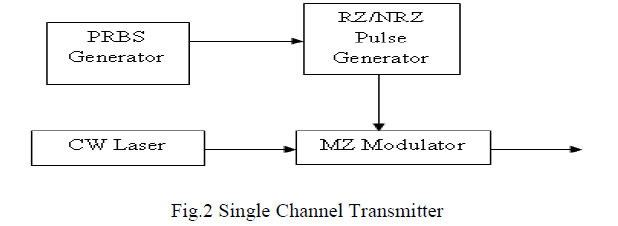 |
| Optical splitter component simulates an “Ideal” optical splitter. The Attenuator is consider to find the minimum receiver sensitivity. Generally the value of the attenuator is taken as 0 dB but to find minimum receiver sensitivity, the attenuator is attenuated from 0 to 4 dB. An ONU receiver consists of the PIN diode, Bessel filter. Photodiode works like a PIN photodiode. The photo detection method generates an output current depends on the input power and dark current. The reference freq/wavelength of photo diode is 192.1 THz/ 1490 nm and zero dark current. BER analyzer measures the performance of the system based on the signal after propagation. It provides the eye-diagram for measuring the Quality factor, threshold level and Bit Error Rate however analyzer is limited to binary signal such as NRZ and RZ. |
RESULTS AND DISCUSSION
|
| The performance analysis of 2Gbit/s downstream transmissions GPON is evaluated. Figure 3 shows Bit Error Rate vs. number of users at different distance (6km, 14km 21km). The bit error rate of 4.9e-22, 8.2e-14 and 1.4e-10 is observed with 64 users at 6km, 14km and 21km distance respectively. It is found that with an increase in the transmission distance, the bit error rate increases. The graph of Q-factor vs. number of users is shown in fig. 4 at different bit rates of 1Gbps and 2Gbps for downstream transmission. The Q-factor of 9.4 and 6.2 observed with 1Gbps and 2Gbps respectively at 21 km transmission distance. As shown in fig 4, we observed that if we increase the no. of users, Q factor decreases due to non linearity and dispersion induced in fiber which degrades the transmission quality. |
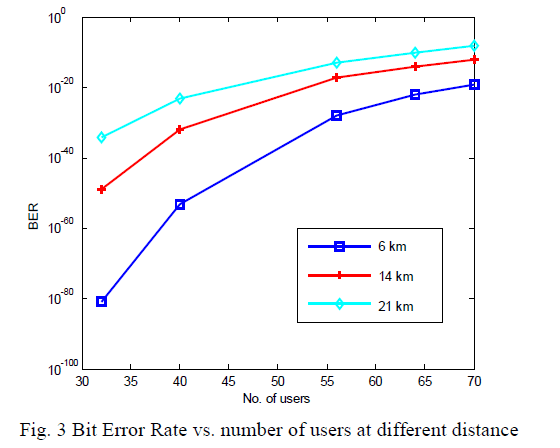 |
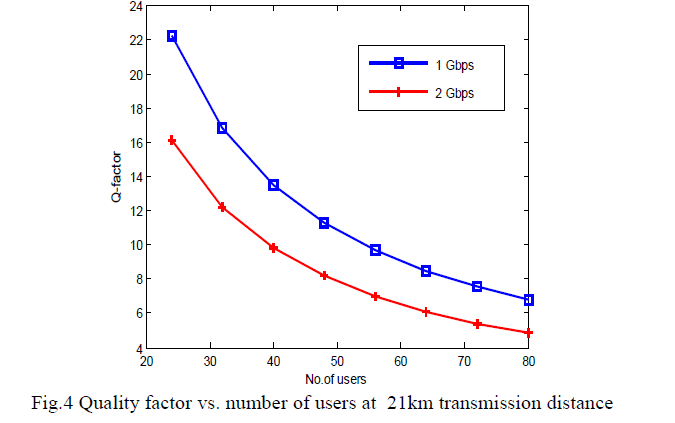 |
| Figure 5 shows Bit Error Rate vs. number of users at different bit rates. For 64 users, bit error rate of 1.8e-21 and 1.8e- 10 observed with 1Gbps and 2Gbps, respectively at 21 km of transmission distance. It is found that with an increase in the number of users, the bit error rate increases. It shows better results over [7, 8] where the BER of 10-9 and Q-Factor of 6 were achieved with 50 users at the optical length of 20km with bit rate of 1.25Gbps. |
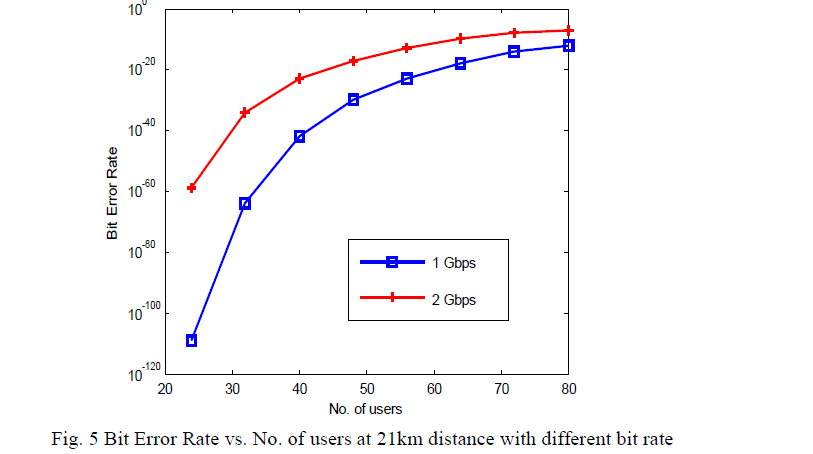 |
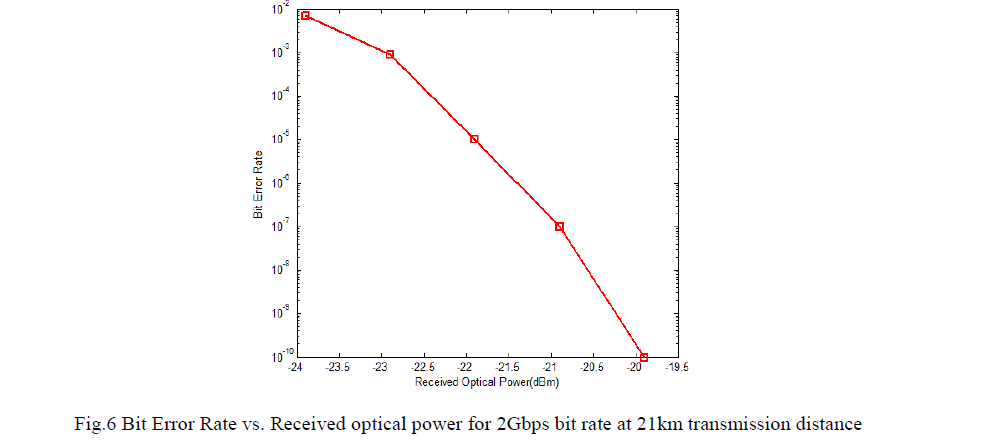 |
| Figure 6 depicts the received optical power vs. bit error rate at bit rate of 2Gbps at 21km transmission distance. It is found that for 64 users, BER of 1.8e-10 is obtained with -19.9dBm received power at the ONU. It is observed that the bit error rate decreases as the received power increases |
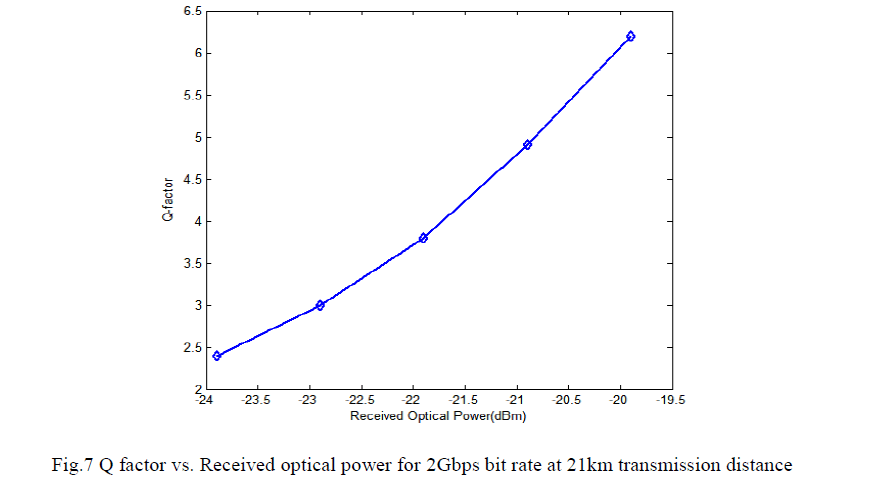 |
| The graph for Q-factor vs. received power is shown in Fig. 7 at bit rate of 2Gbps for downstream transmission. It is obtained that for 64 users, Q- factor 6.2 is obtained with -19.9dBm received power at the 21km transmission distance. It reveals that the Q factor increases as the received power increases. After calculation we get the receiver sensitivity is -21.9 at the distance of 21 km for 64 users. |
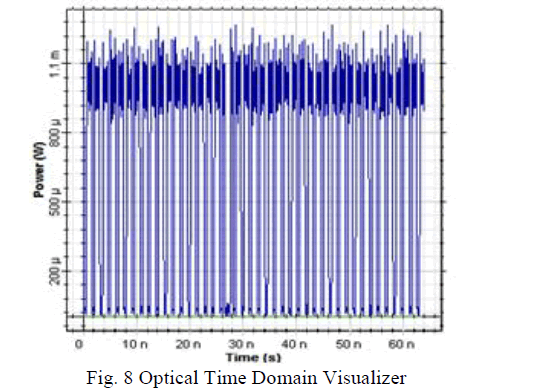 |
| Optical Time Domain spectrum is as shown in fig 8. This visualizer allows the user to calculate and display optical signal in time domain. It displays the signal intensity, frequency and phase parameters. In case of 2 Gbps, we obtain an acceptable value of the BER of 1.4e-10 and Q factor is 6.2. |
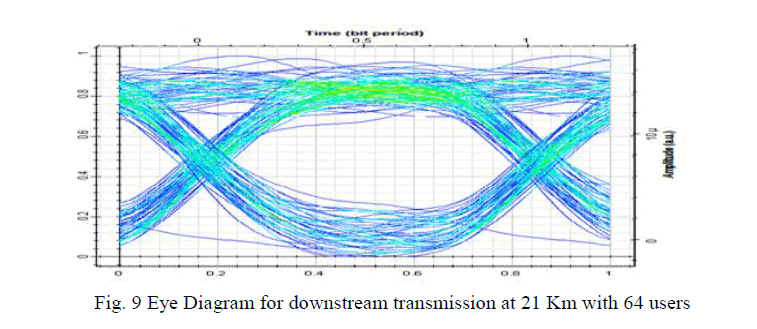 |
| The eye diagram for downstream transmission at 21km transmission distances with 64 users at bit rate of 2Gbps is shown above. The 2Gbps downstream GPON transmission can offer reliable communication and high bandwidth access upto 64 users with a BER of 1.4e-10. |
CONCLUSION
|
| The GPON is the superlative technology for large scale FTTX applications where various end-users require an emergent bandwidth. In this paper, the performance of Gigabit Passive Optical Network using 2Gbps downstream transmission has been evaluated. The system is employed with 64 users on the basis of optical transmission parameters such as Q factor, Bit Error Rate and receiver sensitivity. For 64 users, the optical distance of 21 km with an acceptable quality factor of 6.2 and BER of 1.4e-10 has been achieved. |
References
|
- Bjorn Skubic et.al, “Evaluation of ONU Power Saving Modes for Gigabit- Capable Passive Optical Networks” IEEE Network, vol. 25, No 2, pp20-24, 2011.
- Masamichi Fujiwara et.al,“Field Trial of 100-km Reach Symmetric-Rate 10G-EPON System Using Automatic Level Controlled Burst-ModeSOAs” Journal of Lightwave Technology, vol. 31, No.4, pp 634-640, 2013.
- Naresh Kumar “Improved performance analysis of Gigabit Passive Optical Networks” Journal of Optic, vol.125, No.7, pp 1-4, 2013.
- Russell P. Davey et.al, “DWDM reaches extension of a GPON to 135km” Journal of Light Wave Technology, vol. 24, No.1, pp 29-31, 2013.
- JhongYue Lee et.al, “Comprehensive Performance Assessment of Bipartition Upstream Bandwidth Assignment Schemes in GPON” Journal ofOptical Communication Network, vol. 5, No.11, pp 1285-1295, 2013.
- Zhenxing Wang, et.al, “Sensor Data Transmission Overlay on GPON” Journal of Optical Communication Network, vol.3, No.7, pp 553-558,2013.
- Hesham A. Bakarman et.al, “Simulation of 1.25 GB/s Downstream Transmission Performance of GPON-FTTx” International ConferencePhotonics, pp 1-5, 2010.
- Deeksha Kocher et.al, “Simulation of fiber to the home triple play services at 2Gbit/s Using GE-PON architecture for 56 ONUs” Journal of Optik,vol.124, No. 21, pp 5007-5010, 2013.
- Erik Weis, et.al, “GPON FTTH trial-lessons learned” Journal of SPIE-OSA-IEEE Asia Communications and Photonics, vol. 7633, pp 6330J-1-6330J-7, 2009.
|